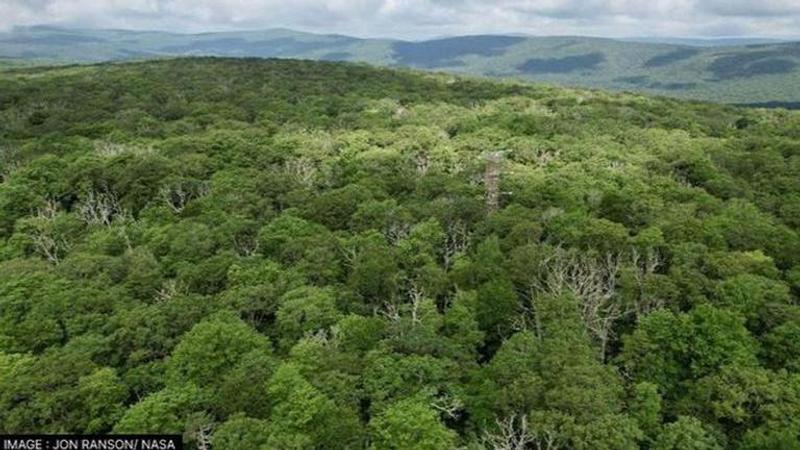Published 11:17 IST, March 8th 2023
NASA to track forest health from space, top US scientist calls for global care
“Trees do a huge service for the planet, in terms of sequestering carbon dioxide, taking it out of the atmosphere and putting it into wood” says NASA scientist.

The United States of America is witnessing a decline in its forest cover. The dwindling forests on the country’s east coast and west coast are the increasing sea levels and wildfires, respectively. The magnitude of the losses and the impacts that declining trees have on atmospheric carbon dioxide concentrations and climate change are difficult to determine from the ground. In order for upcoming Earth-observing missions to better properly assess the health of forests, NASA research scientist Jon Ranson is striving to create new technology for examining trees from the atmosphere.
“Trees do a huge service for the planet, in terms of sequestering carbon dioxide, taking it out of the atmosphere and putting it into wood,” Ranson said. “But trees are very sensitive to our changing climate. We’re trying to see the changes going on in forest ecosystems. If you detect things early enough, you might be able to do something about it,” said Ranson in a statement.
The wavelengths of light reflected by plants can be monitored from aircraft and satellites to provide scientists with information about the rate of photosynthesis, and consequently, the amount of atmospheric carbon dioxide that trees absorb and store. The average of two wide regions of the infrared spectrum, known as NDVI, or Normalized Differential Vegetation Index, is the current benchmark for researching vegetation. The 40-year history of NASA's NDVI data offers a low-resolution but accurate picture of the condition of the forest.
'Trees do a huge service for the planet' says NASA scientist Ranson
According to Ranson, while NDVI is effective for gauging vegetation abundance and vigour generically, a technology known as hyperspectral imaging that breaks infrared and visible light into many more wavelengths can shed light on plants' water content, chlorophyll levels, and even changes in health.
“Vegetation has these broad spectral properties,” said Ian Adams, Earth Sciences Division Technologist at NASA’s Goddard Space Flight Center. “With hyperspectral imaging, you get lots of different measurements at smaller, closer together frequencies. There is a lot more information we can pull out if we can get better spectral resolution.”
Ranson's work supports the priorities of the most recent Earth Science decadal survey, which establishes the field's long-term priorities, by significantly boosting the number of frequencies that are available for investigation. Forests are included in the survey's list of "surface topography and vegetation" as a crucial field of study in need of more sophisticated technologies. Adams further said "strategically for NASA, and more broadly for the remote sensing community, hyperspectral is one of the areas we see as the future.”
Future orbital missions will use hyperspectral imaging, however first data analysis methods must be tested closer to the ground. A visible and infrared (VIS/IR) hyperspectral camera and lidar technology were installed on a Skyfish drone (UAV) from the partner university Virginia Tech by Ranson's team. In a place named Mountain Lake, close to Blacksburg, Virginia, they flew the imaging equipment above woodlands.
‘Are our forests healthy? And if not, why not?” says Ranson on the project
Ranson's team improved estimates of how much carbon the forest removed from the atmosphere by comparing their UAV observations with real CO2 levels measured by sensors on a nearby National Ecological Observatory Network tower.
They were able to improve their methods for analysing the hyperspectral data through these comparisons. For instance, his sensors can identify the circumstance where plants under stress from excessive sunlight release pigments to protect their chloroplasts. Plants may develop leaves with greater surface areas if they receive excessive shadow, which could lead the sensor to overestimate plant productivity. In order to more accurately discern reflections from leaves and other plant elements and eliminate a potential source of inaccuracy, Ranson plans to incorporate short-wave infrared sensors.
Ranson wants to study and examine forests all around the world from space. “We’re trying to get the complete picture,” Ranson said. “So that when we go to space, we know how to find the answer to the question, ‘Are our forests healthy? And if not, why not?”
A mission concept dubbed Concurrent Artificially intelligent Spectrometry and Adaptive Lidar System, or CASALS, has been developed by scientists and engineers at Goddard. If chosen, CASALS would launch a satellite equipped with lidar and hyperspectral cameras. A constellation of such satellites could take the regular observations necessary to quantify changes in forest production over time, using models refined by Ranson's UAV missions.
“Forests take up as much carbon as the ocean does, yet forests cover only 9 percent of Earth’s surface,” said Ranson. “So, if something goes wrong with our forests, it’s a dramatic issue. We’ve got this great, great resource in forests, and we need to care for them so they’ll care for us.”
Updated 09:52 IST, March 9th 2023



